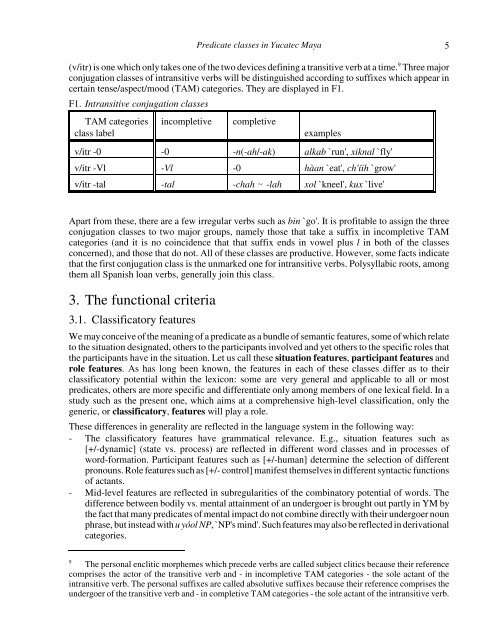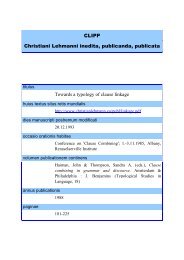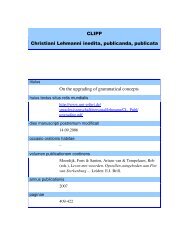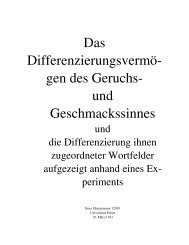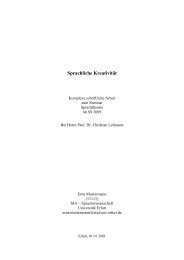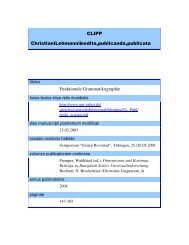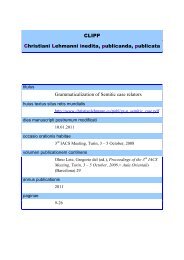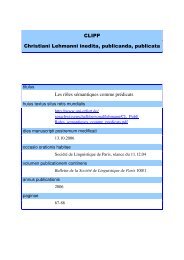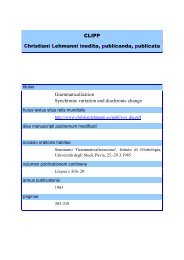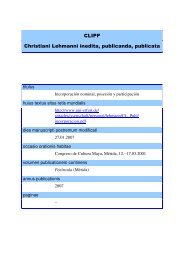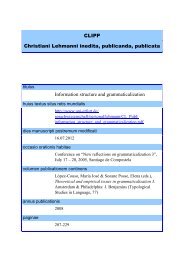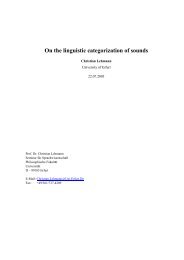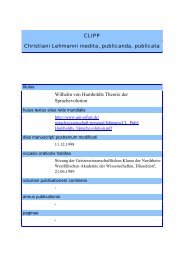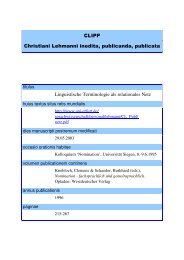CLIPP Christiani Lehmanni inedita, publicanda, publicata Predicate ...
CLIPP Christiani Lehmanni inedita, publicanda, publicata Predicate ...
CLIPP Christiani Lehmanni inedita, publicanda, publicata Predicate ...
Create successful ePaper yourself
Turn your PDF publications into a flip-book with our unique Google optimized e-Paper software.
<strong>Predicate</strong> classes in Yucatec Maya 5<br />
(v/itr) is one which only takes one of the two devices defining a transitive verb at a time. 9 Three major<br />
conjugation classes of intransitive verbs will be distinguished according to suffixes which appear in<br />
certain tense/aspect/mood (TAM) categories. They are displayed in F1.<br />
F1. Intransitive conjugation classes<br />
TAM categories<br />
class label<br />
incompletive completive<br />
examples<br />
v/itr -0 -0 -n(-ah/-ak) alkab `run', xiknal `fly'<br />
v/itr -Vl -Vl -0 hàan `eat', ch'íih `grow'<br />
v/itr -tal -tal -chah -lah xol `kneel', kux `live'<br />
Apart from these, there are a few irregular verbs such as bin `go'. It is profitable to assign the three<br />
conjugation classes to two major groups, namely those that take a suffix in incompletive TAM<br />
categories (and it is no coincidence that that suffix ends in vowel plus l in both of the classes<br />
concerned), and those that do not. All of these classes are productive. However, some facts indicate<br />
that the first conjugation class is the unmarked one for intransitive verbs. Polysyllabic roots, among<br />
them all Spanish loan verbs, generally join this class.<br />
3. The functional criteria<br />
3.1. Classificatory features<br />
We may conceive of the meaning of a predicate as a bundle of semantic features, some of which relate<br />
to the situation designated, others to the participants involved and yet others to the specific roles that<br />
the participants have in the situation. Let us call these situation features, participant features and<br />
role features. As has long been known, the features in each of these classes differ as to their<br />
classificatory potential within the lexicon: some are very general and applicable to all or most<br />
predicates, others are more specific and differentiate only among members of one lexical field. In a<br />
study such as the present one, which aims at a comprehensive high-level classification, only the<br />
generic, or classificatory, features will play a role.<br />
These differences in generality are reflected in the language system in the following way:<br />
- The classificatory features have grammatical relevance. E.g., situation features such as<br />
[+/-dynamic] (state vs. process) are reflected in different word classes and in processes of<br />
word-formation. Participant features such as [+/-human] determine the selection of different<br />
pronouns. Role features such as [+/- control] manifest themselves in different syntactic functions<br />
of actants.<br />
- Mid-level features are reflected in subregularities of the combinatory potential of words. The<br />
difference between bodily vs. mental attainment of an undergoer is brought out partly in YM by<br />
the fact that many predicates of mental impact do not combine directly with their undergoer noun<br />
phrase, but instead with u yóol NP, `NP's mind'. Such features may also be reflected in derivational<br />
categories.<br />
9 The personal enclitic morphemes which precede verbs are called subject clitics because their reference<br />
comprises the actor of the transitive verb and - in incompletive TAM categories - the sole actant of the<br />
intransitive verb. The personal suffixes are called absolutive suffixes because their reference comprises the<br />
undergoer of the transitive verb and - in completive TAM categories - the sole actant of the intransitive verb.


